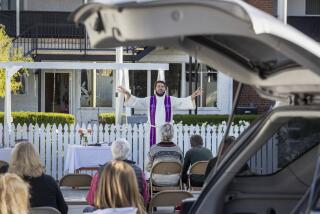Church of the ‘90s Will Need to Get With the Video-Driven Generation
- Share via
To successfully market themselves in the 1990s, churches and synagogues will need to master a new realm of computer and video technology and make some wrenching decisions about their priorities, religious experts predict.
In a video-clip society, such high-tech devices as teleconferencing, sophisticated computer programs, product samples and a “menu” of choices will determine both the style and content of church programs, consultant George Barna recently told a gathering of denominational leaders.
“What used to be called stable is now called inflexible and outdated,” said Barna, president of the Barna Research Group in Glendale. “This is a video-driven generation, with a three- to four-minute attention span . . . (and) used to short, crisp, quick, colorful blocks” of video information.
Most Catholic parishes will “go computerized” for budgets and payroll during the 1990s, according to Father Gene Hemrick, a researcher for the nation’s Catholic bishops. He predicts that entire dioceses will have standardized software programs for records, receipts and accounting before the century is over.
In the next 10 years, routine schedules will be rare. Vacations will be shorter and more frequent. And the wristwatch may be more important than the wallet in determining priorities for churchgoers, according to Barna and other trend-watchers.
Convenience will increasingly become a byword, adds Barna, who conducts marketing surveys for church leaders. Church services won’t necessarily be on Sunday mornings anymore.
“People will look for something that’s ready, available and as simple as possible. . . . Abstract or theoretical ideas won’t interest most people,” Barna says. “They want to be told quickly and efficiently. And they want things they can touch and feel.”
Competence will be critical for the churches of the 1990s, Barna believes. Satisfaction, not loyalty, will be the watchword for church attendance, which Barna thinks may climb at the same time churchgoers decide it isn’t necessary to formally join as members.
There will be no absolutes, adds Barna, only “shades of gray.” Commitments will be situational and short-term. For churchgoers, that means selective participation in events and no “grand loyalty.”
“They will be believers but not belongers, “ declares Steven Tipton, associate professor of religion and sociology at Emory University and its Candler School of Theology in Atlanta.
For United Methodists in the Los Angeles area, the 1990s will bring the realization that some of their present 60 congregations won’t make it into the next century.
“This will be very difficult since closing churches looks like failure rather than a natural part of the life cycle of being born and dying,” according to a Methodist committee report on strategy for the 1990s. “Church grief work for the affected congregations will need to be done. . . .
“Those congregations which survive will clearly be those who can reach out to the surrounding community” providing both spiritual and social services. “The challenge . . . for the 21st Century is learning to minister in poverty and affluent areas, in many more languages, and with many different worship styles.”
Father Rosendo Urrabazo, a Clarentian priest who is president of the Mexican-American Cultural Center in San Antonio, Tex., agrees with the Methodist strategy. To grow in the 1990s, he said, the Catholic Church must challenge existing social structures and take the side of poor people--who compose large segments of the black and Latino communities.
And “the liturgy, the services need to be adapted to the Hispanic community and culture in terms of language, symbols and style,” he adds.
Congregations of the United Church of Christ--down 20% in total membership since 1965--are increasingly adopting mystical practices in their services. Some leaders predict that the trend will spread during the 1990s as churches try innovative techniques to stem membership losses.
Community Congregational Church in Tiburon, for example, has incorporated into its services Tibetan prayer bells, Buddhist chants and other forms of meditation from Eastern and Western religious traditions.
The fast-growing Presbyterian Church in America, a conservative breakaway from the mainline Presbyterian denomination, is experimenting with “perimeter” churches. A “mother” church plants satellite congregations in the suburbs to reach yuppies. The pastors work in the perimeter congregations, but once a month everyone comes together for a “celebration” at the mother church.
During the new decade, churches and synagogues must increasingly come to grips with a thicket of bioethical decisions that involve religious and moral values, declares a prominent rabbi active in the field of bioethics and public policy.
The “major civil rights issues of the 1990s,” says A. James Rudin of the American Jewish Committee, will include medical questions such as withholding life support or resuscitation systems, in-vitro fertilization, organ transplants, allocation of limited medical resources, surrogate parenting, living wills and proxy care legislation.
And abortion.
Sociologist-author Jeffrey Hadden of the University of Virginia says he thinks the magnitude of that issue will eclipse all other tension points within American religion in the 1990s.
More to Read
Sign up for Essential California
The most important California stories and recommendations in your inbox every morning.
You may occasionally receive promotional content from the Los Angeles Times.












